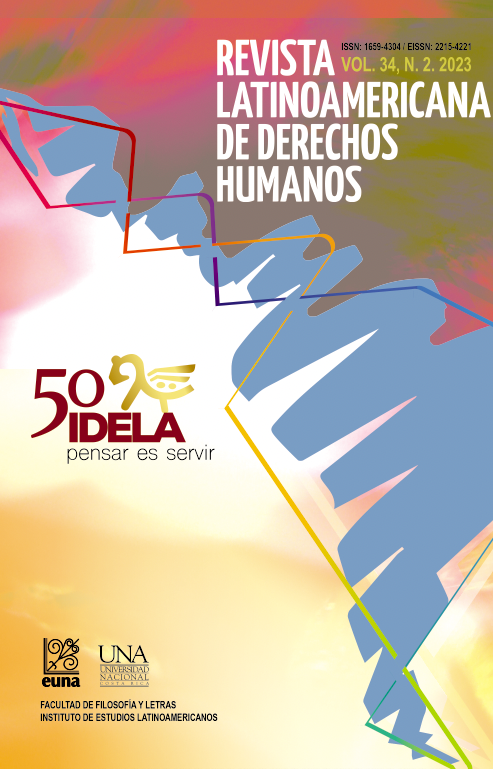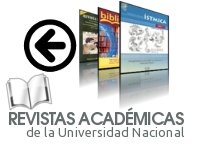Infancies affected by state terrorism in Uruguay
DOI:
https://doi.org/10.15359/rldh.34-2.3Abstract
Through this article I propose to reflect on the memories of the childhoods affected during State terrorism, focusing mainly on Uruguay and from my personal expe- rience. When I was 3 years old, I was kidnapped as part of a Condor Plan operation, my brother and I remained missing for a couple of weeks. The case gained public notoriety and we were handed over to our grandparents; upon returning, as if I had a lump in my throat, nodules appeared on my vocal cords. The body inscribes the memory that the mind forgets. This is not just my story, there are many of us who had childhoods defragmented by State terrorism. Why history hardly talks about us? Why have we not found –in Uruguay– a place in the stories of memory? Why does our voice seem like my voice? that does not sound. These are some of the many questions that the Jacarandá collective asks. Culture of memory we become, and that personally I investigate. There are multiple effects experienced by those of us who spend our childhood during State terrorism and very diverse our experiences, therefore, this article is not exhaustive. In it, some experiences are outlined attempting to look at the childhoods that were the object of multiple violence during the Latin American dictatorships of the 60-80s. In turn, the analysis is approached from the perspective of affections, since this allows us to place emotions in the foreground (Pérez and Capdepón, 2022).
References
Achugar, M. (2020). Documentales y transmisión intergeneracional del pasado reciente: entre la denuncia y la reflexión. En P. Margulis (ed.) Transiciones de lo real. Transfor- maciones políticas, estéticas y tecnológicas en el documental del Cono Sur (Argentina, Chile y Uruguay). Buenos Aires: Editorial Libraria.
Achugar, M. (en prensa). Mirando con otros ojos: memoria, justicia y cine en un filme uruguayo.
Arfuch, L. (2015). Memoria, testimonio, autoficción. Narrativas de infancia en dictadura. https://doi.org/10.7203/KAM.6.7822
Basso, M. F. (2019). Volver a entrar saltando: memoria y arte en la segunda generación de argentinos exiliados en México. https://doi.org/10.35537/10915/80994
Cassariego, F. (2019). (Ed.). Esta es mi historia ¿y la tuya?, Montevideo.
Ciancio, B. (2021). Estudios sobre cine:(pos) memoria, cuerpo, género. Editorial Biblos.
Ciancio, M. B. (2015). ¿ Cómo (no) hacer cosas con imágenes? Sobre el concepto de posmemoria. Constelaciones: Revista de teoría crítica, (7), 503-515.
Feld, C. (2002). Del estrado a la pantalla: las imágenes del juicio a los excomandantes en Argentina, (Vol. 2). Siglo XXI de España Editores.
Forcinito, A. (2006). Narración, testimonio y memorias sobrevivientes: Hacia la posme- moria en la posdictadura uruguaya. Letras femeninas, 32(2), 197-217.
Gatti Casal de Rey, G., Chama, M. S., & González Canosa, M. (2017). Entrevista a Gabriel Gatti Casal de Rey. Aletheia, 7(14), 1-7.
González de Olega, M.; Meloni González, C.; Saiegh Dorín, A. C. (2016). “Infancia, exilio y memoria. Tres relatos de una infancia transterrada tras la última dictadura argentina”. Kamchatka. Revista de análisis cultural 8: 93-109.
Hirsch, M. (2008). The generation of postmemory. Poetics today, 29(1), 103-128. https://doi.org/10.1215/03335372-2007-019
Iglesias y Monteiro. (2016). Estados clandestinos. Un capítulo rioplatense de la Opera- ción Cóndor.
Jelin, E. (2002). Los trabajos de la memoria (Vol. 1). Siglo XXI de España editores. Jelin, E. (2019). La lucha por el pasado: cómo construimos la memoria social. Siglo XXI
Editores.
Llobet, V. (2015). “¿Y vos qué sabés si no lo viviste?”. Infancia y dictadura en un pueblo de provincia. A contracorriente, 12 (3): 1-41.
Norandi, M. (2012). Los hijos del exilio uruguayo en España (1972-1985): la memoria de la segunda generación de una migración forzada. Tesis de Maestría. Departamento de Sociología. Universidad Pública de Navarra.
Peller, M. (2009). Memoria, historia y subjetividad: Notas sobre un film argentino con- temporáneo. Política y cultura, (31), 49-63.
Pérez, M. E. y Capdepón U. (2022). Infancias “afectadas”. Los niños sobrevivientes en los procesos de lesa humanidad y los sitios de memoria. En Políticas, afectos e identidades en América Latina. Coord. Anapios, Lu. y Hammerschmidt, C. Buenos Aires: CLAC- SO; Guadalajara: CALAS; San Martín: UNSAM; Jena: Universidad Jena; Alemania: Bundesministerium für Bildung und Forschung. https://doi.org/10.2307/j.ctv2v88djc.7
Ricoeur, P., & Neira, A. (2008). La memoria, la historia, el olvido - 2a ed. Buenos Aires: Fondo de Cultura Económica.
Ros, A. (2015). El documental político y la generación de posdictadura en Uruguay. En Traverso, A., & Crowder-Taraborrelli, T. El documental político en Argentina, Chile y Uruguay: de los años cincuenta a la década del dos mil. LOM ediciones.
Ros, A. (2008). Inheritance: Living Memory, Leaving Countries. Uruguayan and Argenti- nean Fictionalization at the Turn of the Millennium (Doctoral dissertation).
Winn, P., Stern, S. J., Lorenz, F., & Marchesi, A. (2014). No hay mañana sin ayer: batallas por la memoria histórica en el Cono Sur. LOM ediciones.
Downloads
Published
How to Cite
Issue
Section
License
El material que se publica en esta Revista está bajo una licencia “Creative Commons” 3.0 Costa Rica (CC, Reconocimiento-NoComercial-SinObraDerivada 3.0 Costa Rica (CC BY-NC-ND 3.0 CR) . Esto significa que el material publicado en la revista se puede compartir (copiar y distribuir) en cualquier medio o formato considerando que se debe reconocer de forma adecuada la autoría del material y la fuente, no puede utilizarse con fines comerciales y no se aceptan las obras derivadas (remezclar, transformar o crear a partir del material).








